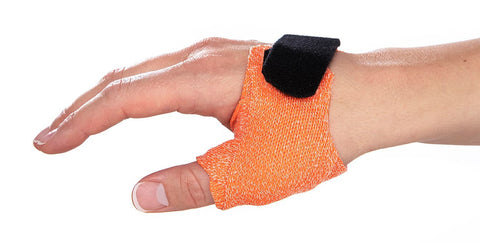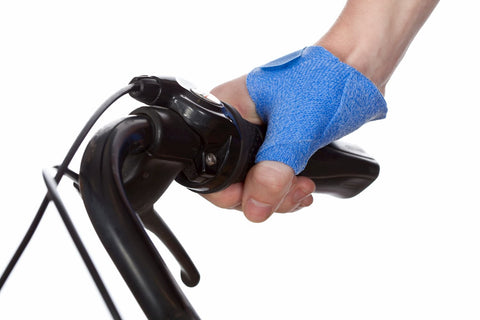The Short Thumb Opponens Orthosis
6 Key factors for thumb splinting
The short thumb opponens orthosis is often used in the treatment of several conditions, such as:
- Osteoarthritis (OA)
- Rheumatoid arthritis (RA)
- Ulnar and radial collateral ligament (UCL and RCL) injuries
- Thumb fractures
And as a conservative treatment intervention in many other conditions where thumb pain is preventing full functional activities.

Short Thumb Opponens Orthosis in Orfilight Black NS.
There are multiple designs for the fabrication of this important orthosis. In fact, every therapist has their favourite design and material. Therapists may choose one specific design for patients with thumb OA and another design for a UCL injury.
We list 6 key factors to consider when making a short thumb opponens orthosis:
- Positioning of the thumb
- Size and shape of the patient’s hand
- Thumb joints to be included
- Daily activities and work requirements of the patient
- Wearing protocol/duration of wear
- Patient/therapist preference
1. Positioning of the thumb
The positioning of the thumb in the orthosis is determined by the clinical diagnosis:
- For reduction of pain at the base of the thumb caused by motion (as seen in OA or RA): Position the thumb in palmar abduction and opposition.
- For immobilization following fracture of the proximal and/or distal phalanx: Position the thumb in full extension.
- For shortened tissue length in the first web space after an injury: Position the thumb in wide abduction.
The clinical diagnosis will guide you to the proper positioning for each individual patient.
2. Size and shape of the patient’s hand
The size of the patient’s hand and its shape can help you determine which material and which thickness to select.
- Size: Larger hands may require 2.0 mm (1/12”) or even 3.2 mm (1/8″) thickness while smaller hands might do well with 1.6 mm (1/16″) or Orficast.
- Bone definition: Hands with very prominent bones might do best with highly confirming materials such as our Orfilight (NS) products or our elastic based products.
- Muscle tone: Hands with high tone and significant contractures might do best with stronger and more rigid materials like Orfit Eco or Orfit Eco Black NS.

The size and shape of the patient’s hand will help you choose the correct material.
3. Thumb joints to be included
Whether your patient has a thumb fracture or osteoarthritis of the carpometacarpal joint, you want to make sure that your orthosis provides the immobilization required for the specific diagnosis involved and only immobilizes the necessary joints.
Should the CMC and MCP joints be included? Is MCP joint immobilization necessary? A short thumb opponens orthosis may:
- Immobilize only the CMC joint
- Immobilize the CMC and MCP joints
- Immobilize all three joints (CMC, MCP, and IP)
It all depends on the specific diagnosis and your specific patient.
4. Daily activities and work requirements of the patient
The daily activities and work requirements of the individual patient may help you determine whether to fabricate a volar, dorsal, radial based or circumferential design.
Does the patient need to wear gloves? You might need to consider a very thin material (such as Orficast or Orficast More) in order to wear the orthosis under work gloves or during sports activities.
Will the patient need to don and doff the orthosis often during the day? Make sure the straps are well attached so they do not come off when pulled.

Carefully consider the patient’s daily activities and work requirements.
5. Wearing protocol/duration of wear
Always consider how long the patient will be wearing the orthosis and their specific circumstances. Make sure to inform your client of the wearing schedule protocol, especially if the orthosis is to be worn only during the day or only during the night.
If the orthosis will be fabricated for a patient who lives quite far from the clinic, you might need to provide additional straps or instructions on what to do if the orthosis feels too tight or too loose after time. Schedule a follow-up appointment so that you can check the fit and make any necessary adjustments.
Consider whether the design and material you have selected will hold up for a longer period than typical. Most orthoses will last for the duration of the rehabilitation period (3-6 months). If you suspect your patient will need their orthosis longer than this time frame, you might need to use a stronger material or a different design. Make sure the patient has a follow up for check-up.
6. Patient/therapist preference
We want to believe that our patients will always follow our advice and wear the orthosis as outlined. But if possible, try to give your patient a choice in the color of the straps or in the materials in order to help with their compliance and adherence to the wearing schedule.
You as the treating therapist should choose a material that you like to work with! Don’t struggle with moulding around the thumb. Pick a material that has high conformity and is easy to mould around the thumb and thenar muscles. This will create a conforming and comfortable orthosis and help your patient stick to his/her wearing schedule for best results.
The short thumb opponens orthosis is a simple design at first sight, yet it involves complex fitting and critical thinking. Keep these 6 factors in mind during the orthotic fabrication process to create effective thumb orthoses for all your patients.
Can’t wait to get started with the fabrication of this staple orthosis? The following solutions and resources will set you off on the right track:
- Find the perfect material for the short thumb opponens orthosis in our thermoplastic products overview. Highly conforming materials such as Orfilight NS and Orfit Colors NS will work very well for this design.
- Check out our thermoplastic pre-cuts for quick and easy orthotic fabrication. They come in a variety of materials and colors.

Orfit precuts come in a wide variety of colors and materials.
- Have a look at the Short Thumb Opponens Orthosis – Splinting Guide featuring a simple pattern and step-by-step instructions.
- Follow along with our instructional video and learn how to make a thumb orthosis from Orficast.
Physical Rehabilitation Product and Educational Specialist at Orfit Industries America.
Debby is a hand therapist with over 34 years of clinical experience. She completed her Doctorate of Occupational Therapy at Rocky Mountain University of Health Professions in 2010.
She is also an adjunct professor at the Occupational Therapy Department of Touro College in NYC and has written many articles for hand therapy journals, including the ASHT Times and the Journal of Hand Therapy.



